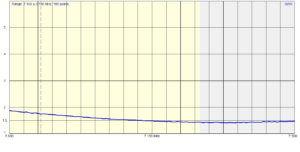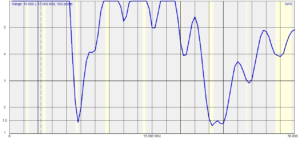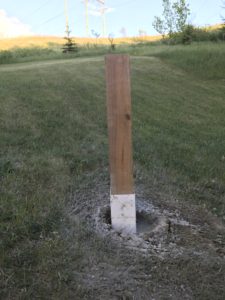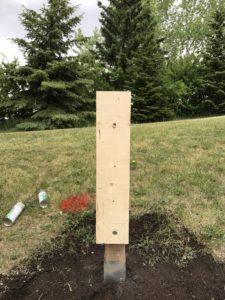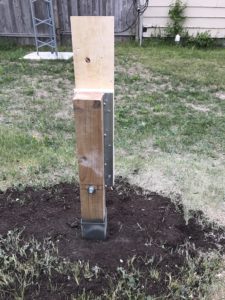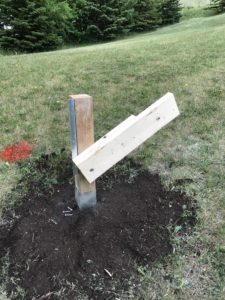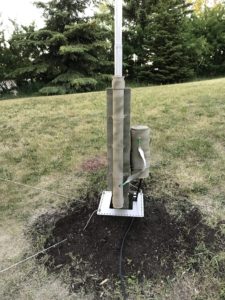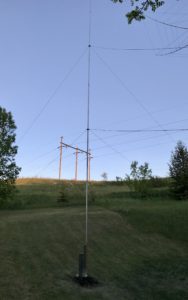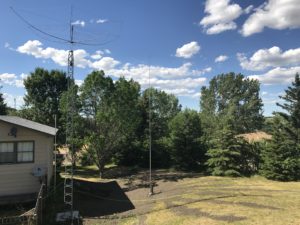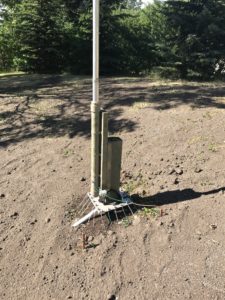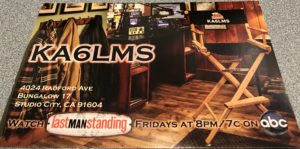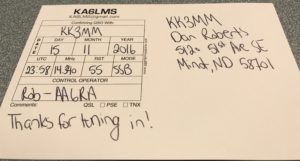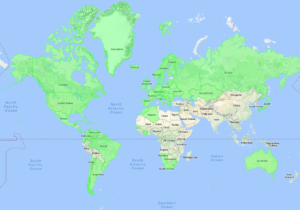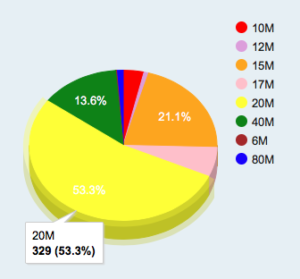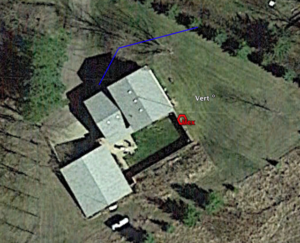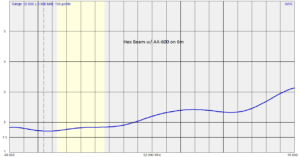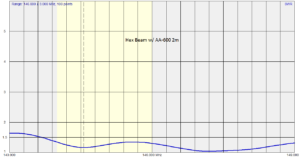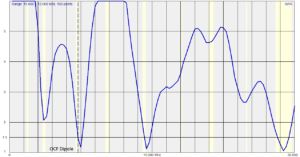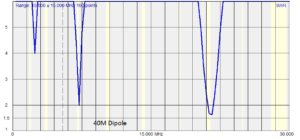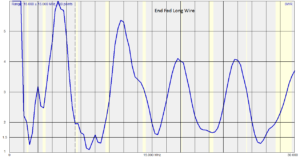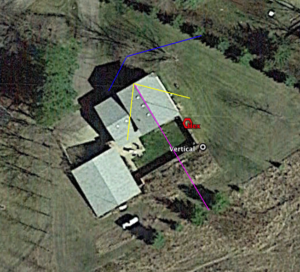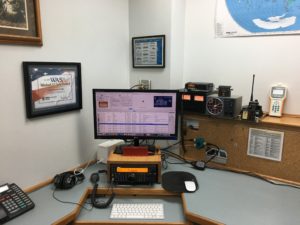Category: General Articles
General Amateur Radio related articles.
The Tower Climb
Reworking the 40m Vertical
Update: 9/22/18 Reworked the guy lines over the summer. Just put it on the analyzer again. Looks pretty good.
Have not been active that much but have 40M phone contacts in Russia, Virgin Islands, New Zealand, Australia, & Brazil.
Update: 6/21/17 Grass is growing in and I just re-installed the bleeder resistor and shortened the antenna about 8 inches. Best I can get the SWR is 1.8:1 on 7.212.
Update: 6/11/17 Must be working OK, worked a new DXCC, Paraguay (Daniel ZP5DBC)
About a year ago I purchased an aluminum tubing kit from DX Engineering. I used this kit along with some PVC pipe to make an insulated mount to create a 1/4 wave 40m vertical. I mounted this to the corner post of my wood fence. I used RG58 to wind an air choke and installed a bleeder resistor to eliminate static build up. I installed a couple of radials on my fence. It makes a great 40m receive antenna, but a very poor transmit antenna. Below are some photos of the current installation.
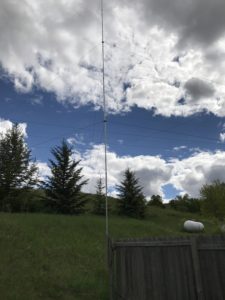
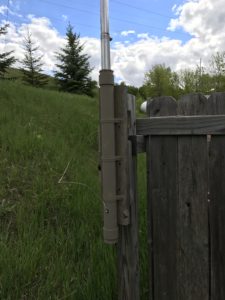

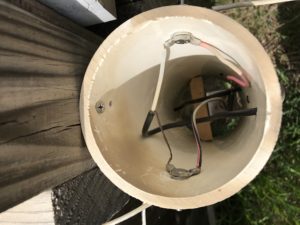
My plan is to install a post near the middle of my side yard and install 20 radials. I purchased the radial plate from DX Engineering.
On Monday May 29th I purchased a 4×4 post and cut it to 5ft. I also purchased a vinyl post jacket. Next I dug a hole 3.5ft deep and place 6 inches of gravel in the bottom. I post inside the jacket and placed in the hold and added 2 bags of sackrete.
On Tuesday I designed a home made tilt mount out of angle iron and 2×6’s.
Wednesday the radial plate arrived. Everything remounted and the first 2 radials installed, only 18 to go for a good start.
Well I had enough wire for 22 radials. Hauled in 5 tons top soils to cover the radials with about 1 inch of soil and then added grass seed.
I also ended up removing the Air Choke. I also tried a 1:1 Current Balun. The SWR is best directly feeding via the coax. Currently 1.8 to at 6.914 MHz. Need to shorten the antenna a bit to get to 7.212 MHz.
Will post some results after final tuning and some on-air time.
DXCC
After upgrading to General my first HF contact was on 1/24/15 with KB6UNC in Utah, USA. My 100th entity contact was on 2/12/17 with C31KC in Andorra.
Only a couple hundred to go 🙂
http://www.arrl.org/dxcc-general-program-faq
DX Code of Conduct http://www.dx-code.org
More about DXing from KE0OG
Joe’s Equipment Advisor – N7IV
Thanks to Joe – N7IV for putting together this info for our new hams.
New and Cheap
A Chinese company makes Baofeng handy-talkies (HT) that work on 2m and 70cm. They are primarily commercial radios that can be made to work on our bands. Here are some things to remember if you are considering buying a Baofeng radio:
- The price is right. There is a lot of bang for the buck
- They are throw-away radios if they break, buy a new one
- They are usually programed with a computer so I suggest that you buy the programming cable that connects the radio to your computer’s USB port.
- They have a rather unusual antenna connector setup. So if you want to hook up an antenna (like a J-pole) you’ll need to buy an SO-239 (female UHF) – to – female SMA adaptor.
They made and are making many different models. Local folks have been happy with their models:
And
New and a Little Better
Wuxon is another Chinese radio company. They make bargain radios too but these radios have two big advantages: 1) are designed specifically for the amateur radio service and can be programmed easily by a human being without a computer; and 2) they are sold by reputable ham radio equipment suppliers.
The down side is that they cost at least three times as much as the BAOFENGs. You might want to consider the WUXON
YAESU FT-60R (this is a Japanese bargain radio designed to compete with the Chinese brands)
Much Better Quality but Only One Band
Both the Wuxon and Baofeng HTs cover both 2m and 70cm. The HTs in this group are mono-band radios. Like the Wuxons, they are sold by major ham radio equipment stores. Unlike the Chinese radios, they are built to exacting specifications by hyper-reputable Japanese companies. You may want to consider a 2-meter HT in this group.
Great Quality, but be Prepared to Open Your Wallet (or Purse)
You can spend more to get more bands (like 1.25M and 6M) but why? We have no 1.25 or 6 meter repeaters in town. You can also spend more to get the fancy features associated with digital radios. I don’t think we have any of those digital radios in town because we are all too cheap. It is probably not a good idea for a novice to buy such costy radio. The radios in this group are very good indeed. Some even have extra bands and other digital features.
Consider a Higher Power Radio
Radios in this group generally put out at least twice the power of an HT. They can be mounted in a vehicle or used at home. If you use one at home, you’ll also need to buy a 12 volt power supply. These radios come in both mono-band and VHF/UHF varieties. You should also consider buying a used radio in this class. I’ve seen nice ones sell at hamfests for under 75 dollars. Here are a few to consider.
Mono-band radios
Dual-band radios
Unique Contacts on HF
According to ClubLog here is the list of the most wanted DXCC entities http://www.clublog.org/mostwanted.php
Here is a pretty neat non-DX contact – KA6LMS – From the set of the ABC TV Show Last Man Standing
My First 2 Years on HF
Year 1 was 100w and Wire Antennas, Year 2 added a tower and beam in the fall, still 100w
- 618 Contacts / 362 LotW Confirmed
- WAS – Complete
- DXCC – 118w/96c
- WAZ – 28w/23c of 40
- Continents – North America, South America, Africa, Europe, Asia, Australia
- Most Distant Contact – ZS6TVB Republic of South Africa 17M 9,326 Miles
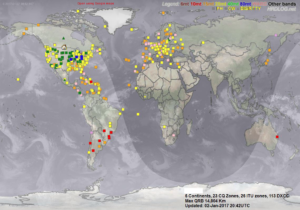
Year 1 Stats
- 275 Contacts / 135 LotW Confirmed
- WAS – 46w/42c of 50
- DXCC – 80w/45c
- WAZ – 22w/18c of 40
- Continents – North America, South America, Africa, Europe, Asia
- Most Distant Contact – LU7YZ Argentina 10M 6,355 Miles
Getting New (young) People into Amateur Radio
A few members of our local club have been doing a great job getting new people started. Here is a quick video about Amateur Radio, check out the links to the left for more info.
Ham Radio and MacOS
Can you live with just MacOS in the shack or is Windows a must?
I have worked in the local phone company (now a broadband company) for almost 25 years. I sold and worked on computers for a few years prior to going to work there, so in total I have been working with/on computers for almost 30 years. Started with TRSDOS and moved to MS-DOS, then Windows 3.11. Next to expand my OS knowledge I spent some time running SCO UNIX, then back to Windows (95b I think). Off to Linux for a bit running Redhat. Then back to Windows and finally 3 years ago I tried Mac OS. I love my iPhone and thought it would be good synergy, and it is!
Just about everything I want to do related to Amateur Radio, I have been able to find a program that runs on the MAC. For radio programming I use Chirp. For logging/contesting I use MacLoggerDX.
So what can’t I run. The firmware updating software for my Kenwood TS-590SG will only run on Windows, as will the graphing software for my RigExperts AA-30.
The solution Boot Camp to dual boot Windows and Mac OS on my MacBook Pro. With the super fast SSD and 8 Gig of ram, my MBP makes a great Windows 10 laptop.
The Tower
The bottom section, which is 4′ tall will be in the concrete, leaveing me 32′ above ground. There will be roughly 2′ of mast putting the base plate of the Hex Beam at 34′.
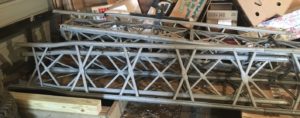









My Antenna Farm
I have been working on getting my antennas to where I want them since getting on HF. I believe this will be a continual work in progress. This article will document the status, struggles and success.
(Update 5/1/18)
- Removed Long Wire.
(Update 6/21/17)
- Moved Vertical see article here.
(Update 5/13/17)
- Removed 40M Dipole and re-installed Long Wire for local net use.
(Update 1/1/2017)
- After working with the 40M Dipole for a while it does not appear to work very well for DX. Probably not high enough. The rule of thumb is, for a nice low take off angle you need to be 1/4 wave length or higher.
- The K4KIO Hexbeam is AMAZING!!!!
- The OCF Dipole is an OK general purpose antenna and works well enough for NVIS on 75/80.
- The Vertical is still very low noise, but does not work every well as a transmit antenna. Not enough radials.
House
- 18.5 Ft to Peak of Gable
- 14 Ft to Facia Board on N Side
- Side 324 degrees
- Front 54 degrees
- Evergreen Row 300 degrees
K4KIO Hex Beam (Red Hexagon)

- 20m – 6m (Also Works on 2m)
- 20m Elements at 25’ High
- Test Results Rig Expert AA-30 and AA-600
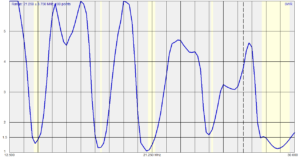
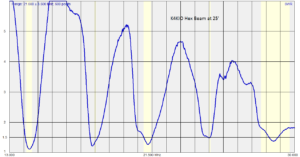
OCFD (Blue)
- 22.5’/44.5’ w/ 4:1 Balun
- Center at 15’ High
- Short Leg is heading 210 degrees w/ End at 8’ High
- Long Leg is heading 75 degrees w/ End at 8’ High
- This antenna will be mainly used for 40m maybe some 75/80m work
- Test Results Rig Expert AA-30
33’ Vertical w/ 22 Radials (White Circle)
- Test Results Rig Expert AA-30
40M Dipole (Yellow) – Removed 5/12/17
- Put Up for DX
- Balun @ 23.5′ High
- Test Results Rig Expert AA-30
Long Wire (Purple) Removed 5/1/18
- 84’ Long w/ 9:1 Unun
- Unun is 23.5’ High
- Heading 330 degrees w/ End at 10’ High
- Works very well on 75m for NVIS
- Test Results Rig Expert AA-30
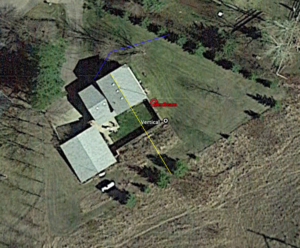
Yaesu FT-857D Installed in a 2014 Jeep Wrangler Rubicon 2 Door
Let’s start on the inside.
Below are photos of the Head, Mic and Body. The head was mounted to the footman’s loop using a Strike Force Zebra mount. The mic is mounted using a Cool Tech LLC Versa Mount 2. The radio body is mounted to a piece of 3″ x 3″ aluminum angle using 2 of the hardtop bolts.
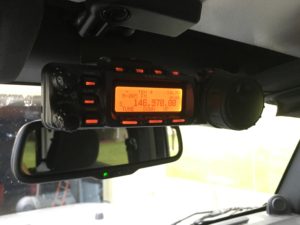
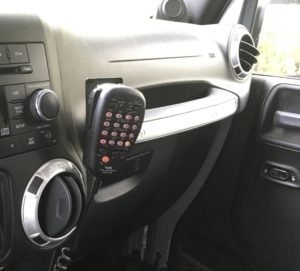
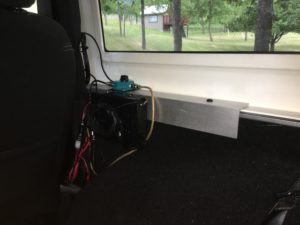
Now for the antennas.
On the front is the Yaesu ATAS 120A mounted using a Diamond Antenna CRM This will be used for 6m – 160m. Next for 2m/70cm is a Comet SBB2 NMO with a Diamond Antenna C101NMO mounted to a 5″ x 5″ piece of flat aluminum. This is mounted inside to protect from trees and brush while offroad and not affected by the fiberglass hardtop. Last is the Larsen 11m antenna that is used with a CB radio when required by the offroad event. This is currently tuned for 10m, also I have 75m MFJ antenna on the way.
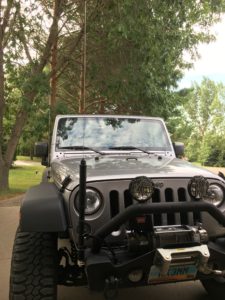
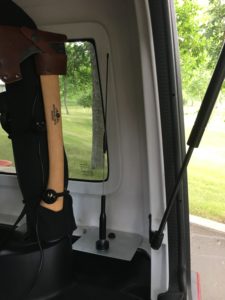
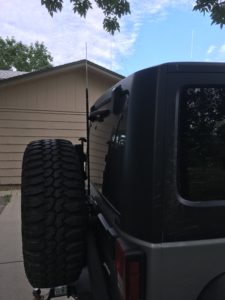
Last is the power. I am not sure why I waited so long to start using Anderson Powerpoles.
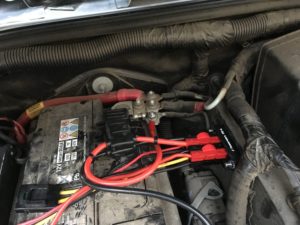
My Rigs
- Shack
- HF – Kenwood TS-590SG
- VHF – Kenwood TM-281A
- Mobile
- HF, VHF & UHF – Yaesu FT-857D w/ ATAS 120A Antenna
- Portable
- Looking at purchasing a TH-F6A
Did some trading last weekend and ended up with the Yaesu FT-857D. Just finished the install in my 2014 Jeep Wrangler Rubicon (2 Door). Will post pics when I post about the install.
Just Finished WAS
I just got confirmation of my last state on Log Book of the World. Thanks to K7EMR for activating Devils Tower which added one on the NPOTA count and better yet happened to be located in Wyoming.
73 Dan KK3MM
